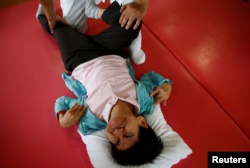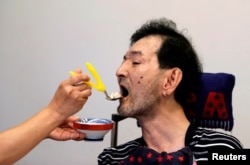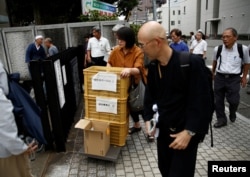Shinobu Sakamoto was just 15 when she left her home in the southern Japanese fishing village of Minamata to go to Stockholm and tell the world of the horrors of mercury poisoning.
Forty-five years on, she is traveling again, this time to Geneva, to attend a gathering of signatories to the first global pact to rein in mercury pollution. The meeting will begin Sunday.
Sakamoto is one of a shrinking group of survivors from a 1950s industrial disaster in which tens of thousands of people were poisoned after wastewater from a chemical plant seeped into the Minamata bay.
The waste contained a toxic organic compound, methylmercury, which can cause severe damage to the brain and nervous system, leading to a condition called Minamata disease. It gives its name to the U.N.-backed treaty that took effect last month.
Symptoms worsen with age, leaving some victims grappling with the question of who will care for them after the death of siblings and parents, while others face legal disputes.
"If I don't say something, no one will know about Minamata disease," said Sakamoto, who is one of the few born with the disease who is still able to talk.
"There are still so many problems, and I want people to know."
Few survivors
Just 528 people survive from among the 3,000 certified victims of Minamata disease, environment ministry data show.
More than 20,000 people have sought to be designated victims, hoping for legal compensation.
"We need to take seriously the fact that there are still many people raising their hands," said ministry official Koji Sasaki, referring to victims' efforts to win recognition.
Born in a family of shipbuilders whose home overlooks the Minamata bay, Jitsuko Tanaka, 64, played on the beach with her older sister when they were children, picking and eating shellfish, unaware it was contaminated with mercury.
She was almost 3, and her sister 5, when they lost the ability to move their hands freely and walk properly, becoming the first to be identified as disease sufferers.
Tanaka's sister died at age 8. Tanaka survived, but the poisoning left her too weak to walk without support. A few years ago, her family said, even that became impossible.
As she lay motionless in bed, her brother-in-law, a fellow sufferer, said he worried about the patients left behind when family members die.
"After I die, who will take care of her?" asked Yoshio Shimoda, 69.
Time is no healer
In the 61 years since Minamata disease was identified, the grim struggles have eased for only a few.
Before the government named methylmercury as its cause in 1968, disease sufferers faced discrimination over fears it was contagious, which deterred many from seeking legal recognition.
People still send in decades-old umbilical cords to be checked for contamination, hoping for evidence to support their claims to be designated as victims, said Hirokatsu Akagi, director of Minamata's International Mercury Laboratory.
Sakamoto, poisoned while still in the womb, considers it her duty to tell the world about the dangers of mercury.
"Minamata disease isn't over; it's not a thing of the past."













